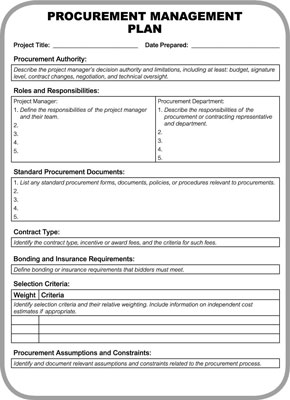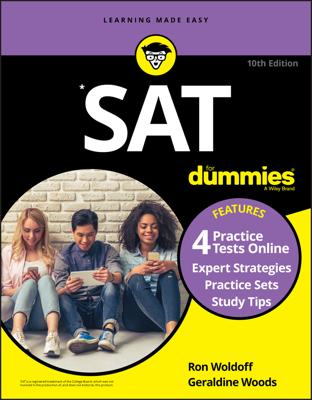You will need to know all about the procurement management plan for the PMP Certification Exam. After deciding which elements to make and which to buy and selecting the contract type, you can document your procurement management plan, develop procurement documents and the SOW, and define your source selection criterion.
The procurement management plan
A component of the overall project management plan, the procurement management plan describes how all facets of the procurement will be conducted. For small projects with simple purchases, a paragraph in the project management plan will suffice. For complex procurements, or when a project has numerous procurements or high-risk procurements, the plan should be more detailed and robust.
The following components are fairly common for a procurement management plan, but obviously, the needs of the project will dictate the contents:
Type of contract for each procurement
Roles, responsibilities, and limits of decision-making authority on procurements
Relevant policies, procedures, guidelines, and templates
Strategy for managing and integrating multiple procurements
Strategy for integrating procurements into the rest of the project
Procurement assumptions and constraints
Strategy for handling long lead items
Procurement milestones for each procurement
Reporting requirements for sellers
Required bonds, warranties, insurance, licenses, and permits
Format for the SOW
How and if independent cost estimates will be used
A list of prequalified sellers
Selection criteria and weighting
Processes for managing contracts
Process for procurement audits
Risk management issues

Source selection criteria
The source selection criteria listed in the procurement management plan will be used to score seller proposals and should be specific to the item(s) being procured. Here are some items to keep in mind while you establish source selection criteria:
Understanding of need
Overall cost (includes operating and maintenance costs)
Financial capacity
Technical capability and approach
Management approach
Risk sharing
Production capacity
Business type (for example, women- or minority-owned or small business)
Past performance and references
Warranty
Intellectual property and proprietary rights
The criteria that are essential to being able to perform the contract are screening criteria. If a proposal doesn’t demonstrate that the seller meets the criteria, then the seller is screened out of the process. Examples include needing specific licenses, having a minimum number of years of experience, or being financially sound.
U.S. federal government contracts require that the source selection criteria be published. However, many commercial procurements do not publish the selection criteria.
Some criteria can be set up as a weighting system. In this case, you identify the most relevant criteria and then weight them relative to one another. Here are the steps involved, along with a simple example:
Establish the criteria you will evaluate proposals against.
For this scenario, you decide on cost, references, and schedule.
Rank the criteria in order of importance.
You decide on schedule, cost, and then references.
Establish a relative numeric weight for each criterion.
Schedule = 50%
Cost = 30%
References = 20%
Determine how you will objectively score proposals.
1 2 3 4 5 Schedule Can’t deliver in April Can deliver by April 30 Can deliver by April 20 Can deliver by April 10 Can deliver by April 1 Cost Costs more than $120K Costs between $110–$120K Costs between $105–$110K Costs between $100–$105K Costs less than $100K References No references More than one mediocre reference Up to two great references More than two great references All references were great Score the proposal.
You determine scores by comparing the information in the seller’s proposal against the Proposal Weighting Criteria.
Multiply each vendor’s scores by its weight to get a rating, and then sum the ratings.
Weight Company A Company B Company C Score Rating Score Rating Score Rating Schedule .5 4 2 3 1.5 4 2 Cost .3 5 1.5 3 .9 4 1.2 References .2 4 .8 4 .8 3 .6 Total 4.3 3.2 3.8 Select the proposal with the highest total rating.
Procurement statement of work
The procurement statement of work (SOW) is a narrative description of the work to be done. It describes the deliverables in sufficient detail to allow sellers to determine whether they can complete the work, but it doesn’t define how the work must be done.
The SOW can be very simple or very complex, depending on the needs of the project. Because it is the meat of the contract, it needs to be clear, concise, and not open to interpretation.
You might see the following types of elements in a procurement SOW:
Specifications
Performance requirements
Support work, such as training and documentation
Quality requirements
Reporting requirements
The specifications, performance requirements, and support work will be defined and elaborated as part of the project scope definition. The quality requirements are defined as part of the Plan Quality Management process. Reporting requirements should mirror the reporting needs for the overall project.
Procurement documents
Procurement documents make up the package you send out to potential sellers. This package can be called a bid, tender, or quotation when the primary deciding factor is price. When the buyer is looking for a technical solution and is weighing factors other than price, you might hear the term proposal. Common terms for procurement documents are
Request for Quote (RFQ)
Invitation for Bid (IFB)
Request for Proposal (RFP)
Invitation for Negotiation
Tender Notice
The procurement documents contain the SOW, instructions on how and when to respond, and any required contractual provisions.

